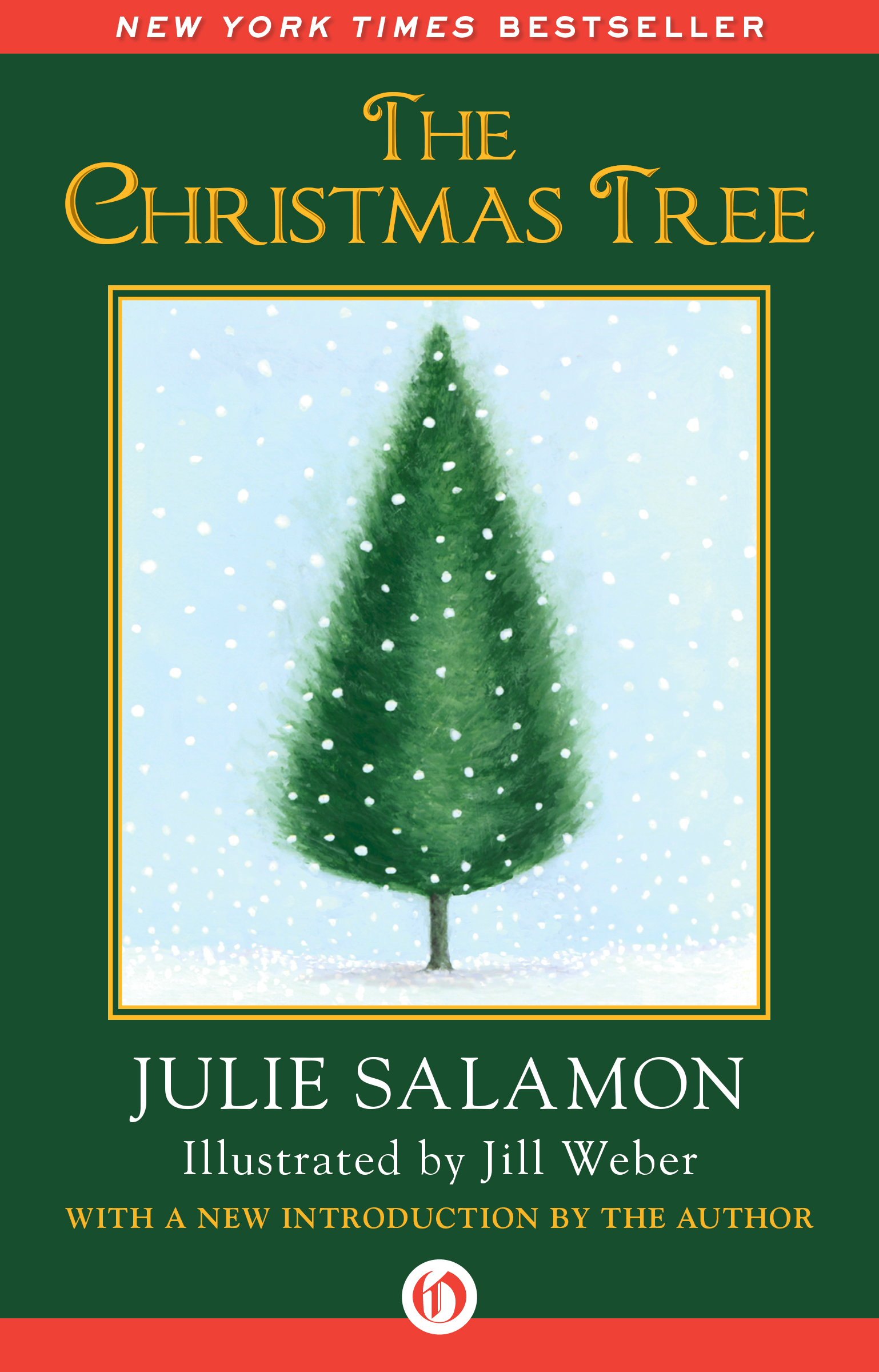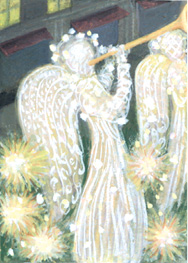The Christmas Tree
Read The Christmas Tree Online
Authors: Jill; Julie; Weber Salamon



FRESH EBOOK DEALS, DELIVERED DAILY
BE THE FIRST TO KNOWâ
NEW DEALS HATCH EVERY DAY!

Illustrated by Jill Weber

For our children
Roxie and Eli Salamon-Abrams
and
Remy Weber
Introduction
While I was writing
The Christmas Tree
in 1996, the mystery of life's journeys was very much on my mind. My daughter was in first grade and my son was one year old. I had just completed a memoir about my parents' journey from Eastern Europe to the tiny town (population seven hundred) in southern Ohio where I grew up. Since 1975, New York City had become my home. I had a good career as a journalist and a promising start as an author.
My expectations for this novella were modest. Could I tell a good story that adults and children would enjoy and find worthwhile? I had no expectations beyond that, certainly not for what followed.
The Christmas Tree
would become a
New York Times
bestseller, translated into a dozen languages. Two decades later people would still be writing affectionate reviews, and I would continue to receive letters from people all over the world, telling me how much the book meant to themâand to report that now their children are reading it to their own families.
The older I get, the more amazed I am by the enduring power of stories, for both readers and writers. Creating this book provided me a way to connect the raw beauty and uncertainty of my rural childhood to the fulfillment I'd found in New York, a city that can be harsh or awe-inspiring, depending on the day. Many of the places you'll read about in these pages were built on memories of Adams County, Ohio, as well as teachers I've valued and friends I've loved. The writing also helped me come to terms with the inevitability of loss. For each reader, the story will have a different meaning, based on a different set of experiences, yet all connected by one text.
The Christmas Tree
was the first time I'd worked with an illustrator. How lucky I was to be matched up with Jill Weber, a gifted artist who would become a friend and future collaborator. She lives on a farm in New Hampshire; I still live in Manhattan. We didn't meet face-to-face until after we'd finished the entire book. After that, we continued on our separate careers. But we always stayed in touch and a few years ago reunited to collaborate again on books (
Cat in the City
and
Mutt's Promise
) aimed at children in the eight- to twelve-year-old range.
We are grateful to Open Road for reissuing
The Christmas Tree
in time to celebrate the twentieth anniversary of its original publication. Jill's son, Remy, had just graduated college when the book first came out; now he has children old enough to read it on their own. My daughter, Roxie, has become a teacher and my son, Eli, is a new college graduate, ready to begin life as an adult. Jill's husband, Frank Weber, and my husband, Bill Abrams, continue to provide invaluable love and encouragementâand that most precious commodity, a fine-tuned sense of humor. As always, this book (and everything else we do) is dedicated to them, the families we hold most dear.
Julie Salamon
March 2016
Prologue

I'm not a sentimental man, but when I saw her standing there, under the Christmas tree at Rockefeller Center, I started to cry.
She was not a young woman; in fact, she was fairly old. But her eyes stayed fixed on the star at the top of the tree with the curiosity and amazement of a child who has just discovered something new and wonderful. With her bright, bony face barely poking out of her black habit she looked like a little bird next to that giant tree. Only later would I understand exactly what lay behind the sparkle in her eyes, what it all meant to her.
Her name was Sister Anthony, and she was a friend of mine.
An unlikely friend, I suppose. I'm still not sure she ever knew what she did for me. But that's how it goes, I guess. You're touched by something or someone here and react to it over there and most times you don't connect one thing to the other. With Sister Anthony I knew, and I am grateful for that.
Forgive me. I'm getting ahead of myself. Let me tell you who I am and how I found myself in tears at an event that had become routine for me long ago.
I am the chief gardener at Rockefeller Center, though I think of myself as a magician of sorts. It's up to me to conjure up a Christmas tree every yearâa tree so grand, so impressiveâso magicalâthat it can stop New Yorkers in their tracks. If you've ever seen people flying around Manhattan, especially at Christmas, you can appreciate why I always get a little nervous this time of year.
It's enough to make you dread the season. We've had so many perfect trees perfection has become the norm. When you get 100 out of 100 every year you get no praise for getting 100 again, only complaints if you don't.
What is perfection?
It's hard to describe exactly what makes the perfect Christmas tree. The physical requirements are straightforward enough. The tree must stand tall and straight. Its branches must be thick and graceful, and they must point upward, giving the impression that they are reaching to the sky. They also have to be flexible, since they are tied down during the long journey to New York City.
But the trees that are finally selected need something more than height, thickness and supplenessâeven more than mere beauty. And that's where I come in. I'm not an exceptional fellow in most ways, but I do have this gift. I can see if a tree has character, a spirit that outshines the ornaments and tinsel and lightsâif its beauty comes from the inside and not just the outside.
I don't know how to put it any other way. I've often wished I had the same gift with people.
Walk through any park and you'll be able to find them, if you look for the right signs. In summer, the grass around their trunks will be flattened and brown because so many people have sat there. In winter, you feel warmer just looking at them; the wind seems to stop when it comes their way. They are contradictory, these trees: gigantic and sturdy, yet gentle and comforting. It has something to do with the way they hold their branches.
We've had a white spruce now and again over the years and there were a couple of Douglas firs, but that was before my time. Usually, though, we've had our best luck with Norway spruces. They're nice and green, not like the Colorado spruces, which have a blue tint. Sometimes when I'm asked why so many of the Christmas trees have been Norway spruces I'll make up a story about how they've got the right spirit because they grow so close to the North Pole. People like that.
But the real reason isn't quite so romantic. The real reason is that Norway spruces are easy to find. And they grow pretty fast, for an evergreen tree.
You wouldn't catch me planting them, though. They don't live all that long. They can start getting ragged and broken when they're as young as thirty, just when other trees are hitting their stride. Although that hasn't seemed to bother anyone else. Norway spruces were brought here by the Germanic people of Northern Europe when they settled the Northeast, maybe for sentimental reasons. And people have been planting them ever since.
Even so, the search for the Christmas tree can take a long time. I start looking for next year's tree before this year's tree is lit. I never want to relive the year we didn't find the tree until September. That might not seem late at all, but Christmas is a very big deal at Rockefeller Center. The preparations alone are enormous. We have these super-giant ornaments that take a week
each
to install, not to mention the mountains of pinecones and bells we put up all over the place, the giant toy soldiers, the poinsettias. You can get lost in Christmas.
I have people scouting for me in all the states around New York, even as far as Canada. They call me when they think they've found the tree and after they've checked with the owners, who couldn't be more delighted to have us come and take away this giant monster growing in their backyard before it falls and breaks through their roof.
I always go to check it out, even though I know before I go this probably won't be the one. But you have to go, because the one tree you overlook is sure to be it.
No matter where I go, I'm always looking for the tree. Sometimes I take a helicopter; I can cover half a county in a day. But most often I'm in my car. As I drive along I keep one eye on the road, and one eye in the sky, hoping to see that tantalizing bit of green, that mysterious mixture of majesty and magic. Sometimes when I've been on the road too long I imagine the trees are waving to me, calling me over.
For a minute I feel exhilarated.
I've found it,
I'll think. But then I have to figure out how to reach that seductive treetop. A lot of times the trees are in somebody's backyard in a suburb filled with one-way streets. You can spend an hour circling around trying to find this beautiful tree. Then, when you get there, you discover the bottom's a mess. It's jammed up against a wall or has been ruined by trimming.
Other times, I may find the right treeâbut that turns out to be only the beginning. This may sound peculiar, but sometimes the search for the Christmas tree feels a little like an old-fashioned courtship. A lot of people grow very attached to their trees. They love them. I've been amazed to discover the hold a tree can have on a person. I have learned to wait for the moment when, for one reason or another, the owners are ready to part with their treesâand that can take years.
Why am I telling you this?
Well, I've seen where the Christmas trees come from. I've seen them when they were glorious without a single ornament on them. But like most of us I've been so busy getting to where I'm going I haven't had a lot of time to think about where I've been. It only hit me, how lucky I am, that day at Rockefeller Center, when I realized I would never look at the Christmas treeâor my life, for that matterâthe same way again.
Which brings me back to Sister Anthony.
